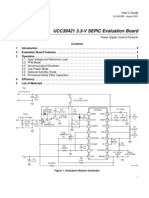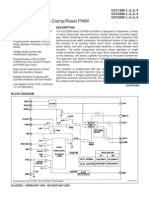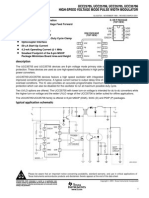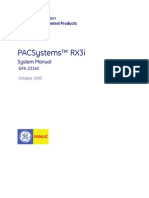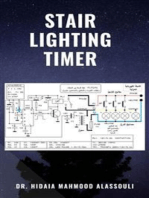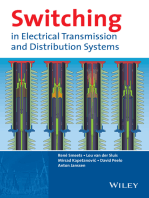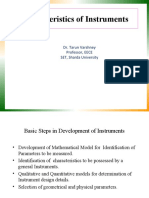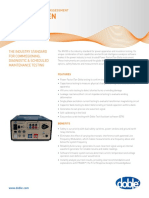Interleaved DC-DC Boost Converter With Built-In MPPT Algorithm
Interleaved DC-DC Boost Converter With Built-In MPPT Algorithm
Uploaded by
Anudeep ReddyCopyright:
Available Formats
Interleaved DC-DC Boost Converter With Built-In MPPT Algorithm
Interleaved DC-DC Boost Converter With Built-In MPPT Algorithm
Uploaded by
Anudeep ReddyOriginal Title
Copyright
Available Formats
Share this document
Did you find this document useful?
Is this content inappropriate?
Copyright:
Available Formats
Interleaved DC-DC Boost Converter With Built-In MPPT Algorithm
Interleaved DC-DC Boost Converter With Built-In MPPT Algorithm
Uploaded by
Anudeep ReddyCopyright:
Available Formats
Preliminary data
This is preliminary information on a new product now in development or undergoing evaluation. Details are subject to
change without notice.
November 2010 Doc ID 17588 Rev 2 1/18
18
SPV1020
Interleaved DC-DC boost converter with built-in MPPT algorithm
Features
PWM mode DC-DC boost converter
Duty cycle controlled by MPPT ALGORITHM
with 0.2% accuracy
Operating voltage range 0-45 V
Overvoltage, overcurrent, overtemperature
protections
Built in soft-start
Up to 98% efficiency
Automatic transition to burst mode for
improved efficiency at low solar radiation
SPI interface
Applications
Photovoltaic panels
Description
SPV1020 is a monolithic DC-DC boost converter
designed to maximize the power generated by
photovoltaic panels independently of temperature
and amount of solar radiation.
The optimization of the power conversion is
obtained with an embedded logic which performs
the MPPT (max power point tracking) algorithm
on the PV cells connected to the converter.
One or more converters can be housed in the
connection box of PV panels, replacing the
bypass diodes, and thanks to the fact that the
maximum power point is locally computed, the
efficiency at system level will be higher than the
one of conventional topologies, where the MPP is
computed in the main centralized inverter.
For a cost effective application solution and
miniaturization needs, SPV1020 embeds the
power MOSFETs for active switches and
synchronous rectification, minimizing the number
of external devices. Furthermore, the 4 phase
interleaved topology of the DC-DC converter
allows to avoid the use electrolytic capacitors,
which would severely limit the lifetime.
It works at fixed frequency in PWM mode, where
the duty cycle is controlled by the embedded logic
running a Perturb&Observe MPPT algorithm. The
switching frequency, internally generated and set
by default at 100 kHz, is externally tunable, while
the duty cycle can range from 5% to 90% with a
step of 0.2%.
Safety of the application is guaranteed by
stopping the drivers in case of output overvoltage
or overtemperature.
Table 1. Device summary
Order codes Package Packaging
SPV1020 PowerSSO-36 Tube
PowerSSO-36
www.st.com
Contents SPV1020
2/18 Doc ID 17588 Rev 2
Contents
1 Application circuit . . . . . . . . . . . . . . . . . . . . . . . . . . . . . . . . . . . . . . . . . . . 3
2 Pin connection . . . . . . . . . . . . . . . . . . . . . . . . . . . . . . . . . . . . . . . . . . . . . . 4
3 Maximum ratings . . . . . . . . . . . . . . . . . . . . . . . . . . . . . . . . . . . . . . . . . . . . 6
3.1 Absolute maximum ratings . . . . . . . . . . . . . . . . . . . . . . . . . . . . . . . . . . . . . 6
4 Electrical characteristics . . . . . . . . . . . . . . . . . . . . . . . . . . . . . . . . . . . . . 7
5 Detailed description . . . . . . . . . . . . . . . . . . . . . . . . . . . . . . . . . . . . . . . . . 8
5.1 Initialization and start-up mode . . . . . . . . . . . . . . . . . . . . . . . . . . . . . . . . . 8
5.2 Oscillator . . . . . . . . . . . . . . . . . . . . . . . . . . . . . . . . . . . . . . . . . . . . . . . . . . 9
5.3 Input voltage sensing . . . . . . . . . . . . . . . . . . . . . . . . . . . . . . . . . . . . . . . . . 9
5.4 Output voltage sensing and over voltage protection ovp . . . . . . . . . . . . . 10
5.5 Over current protection OCP . . . . . . . . . . . . . . . . . . . . . . . . . . . . . . . . . . 10
5.6 Over temperature protection OTP . . . . . . . . . . . . . . . . . . . . . . . . . . . . . . 11
5.7 Shut-down . . . . . . . . . . . . . . . . . . . . . . . . . . . . . . . . . . . . . . . . . . . . . . . . 11
5.8 Under voltage lock-out (UVLO) . . . . . . . . . . . . . . . . . . . . . . . . . . . . . . . . 11
5.9 MPPT . . . . . . . . . . . . . . . . . . . . . . . . . . . . . . . . . . . . . . . . . . . . . . . . . . . . 11
5.10 SPI . . . . . . . . . . . . . . . . . . . . . . . . . . . . . . . . . . . . . . . . . . . . . . . . . . . . . . 11
5.11 SPI timing diagram . . . . . . . . . . . . . . . . . . . . . . . . . . . . . . . . . . . . . . . . . . 13
6 Package mechanical data . . . . . . . . . . . . . . . . . . . . . . . . . . . . . . . . . . . . 15
7 Revision history . . . . . . . . . . . . . . . . . . . . . . . . . . . . . . . . . . . . . . . . . . . 17
SPV1020 Application circuit
Doc ID 17588 Rev 2 3/18
1 Application circuit
Figure 1. Application circuit
VOUT
CB3
LX3
PGND
VOUT
VOUT_SNS
OSC_IN
PZ_OUT
VOUT
CB1
LX1
PGND
LX2
CB2
VOUT
VCC
VIN_SNS
VIN_SNS_MINUS
XCS
SPI_DATA_IN
SPI_DATA_OUT
SGND
SPI_CLK
LX4
CB4
VREG
PGND
VOUT +
PGND
L1
L2
L3
L4
C1
C2
C3
C4
R1
R3
R4
C7
R5
C9
R2
C8
C6
C11
Vin -
Pin 19 Pin 18
D2
D3
PV Cells
D1
Vin +
VOUT -
C12
C13
Pin connection SPV1020
4/18 Doc ID 17588 Rev 2
2 Pin connection
Figure 2. Pin connection (top view)
PowerSSO36
SPV1020 Pin connection
Doc ID 17588 Rev 2 5/18
Table 2. Pin description
Pin n
Name Type Description
PSSO36
34 VIN Supply DC input power supply unit.
7,8,17,18,19,20,29,30 VOUT Supply Booster output voltage
12,13,24,25 PGND Ground Power ground
1 SGND Ground Signal ground reference.
22,23,26,27,15,14,11,1
0
LX14 I Booster inductor connection.
9,16,21,28 CB14 I/O
External bootstrap capacitors have to be connected
between these pins and LXi
5 VREG I/O
Power supply for internal low voltage circuitry; an external
thank capacitor has to be connected to this pin versus
SGND
35 VIN_SNS I
Sense pin of input voltage. To be biased with a resistor
divider between VIN and SGND
3 VOUT_SNS I
Sense pin of output voltage. To be biased with a resistor
divider between VOUT and SGND
31 XCS I To activate the SPI
36 VIN_SNS_M I Dedicated ground for Vin Sense
2 PZ_OUT I/O
This pin is used to compensate the feedback loop of the
output voltage. A series of resistor and capacitor has to be
connected versus SGND.
6 SPI_DATA_OUT O Data OUT for SPI Interface
33 SPI_CLK I Clock for SPI Interface.
32 SPI_DATA_IN I Data IN for SPI Interface.
4 OSC_IN I
Pin for fine tuning of the switching frequency; to set the
default value (100 kHz) this pin has to be tied to VREG,
otherwise for fine tuning it has to be biased through a
resistor versus SGND
Maximum ratings SPV1020
6/18 Doc ID 17588 Rev 2
3 Maximum ratings
3.1 Absolute maximum ratings
Table 3. Absolute maximum ratings
Symbol Parameter
Range
[min, max]
Unit
VIN Power supply [-0.3, 45] V
VOUT Power supply [-0.3, 45] V
PGND Power ground 0 V
SGND Signal ground [-0.3, 0.3] V
VOUT_SNS Analog input [-0.3, VOUT + 0.3] V
LX1.4 Analog input [-0.3, VOUT + 0.3] V
CB14 Analog input/output [Lxi 0.3, Lxi + 5] V
VREG Analog input/output [-0.3, 6] V
VIN_SNS Analog input [-0.3, VIN + 0.3] V
XCS Analog input [-0.3, VIN + 0.3] V
OSC_IN Analog input [-0.3, VIN + 0.3] V
PZ_OUT Analog input/output [-0.3, VIN + 0.3] V
SPI_DATA_OUT Analog output [-0.3, VIN + 0.3] V
SPI_CLK Digital input [-0.3, VIN + 0.3] V
SPI_DATA_IN Digital input [-0.3, VIN + 0.3] V
VIN_SNS_M Dedicated ground [-0.3, 0.3] V
Table 4. Thermal data
Symbol Parameter Min Typ Max Unit
R
thJA
Thermal resistance, junction-to-ambient - 24 C/W
Tj
op
Junction temperature operating range -
C
Tstg Storage temperature -50 - 125
SPV1020 Electrical characteristics
Doc ID 17588 Rev 2 7/18
4 Electrical characteristics
V
IN
=36 V, T
A
=-40 C to 85 C and T
J
<125 C, unless otherwise specified.
Table 5. Electrical characteristics
Symbol Parameter Test condition Min Typ Max Unit
Input source section
V
IN
Operating input voltage 6.5 45 V
I
q
Quiescent current
ILOAD=0mA, VOUT=36V,
SHUT=0V, Tj=Tamb, PWM=5%
5 mA
I
SD
Shut down mode current consumption
ILOAD=0mA, VOUT=36V,
SHUT=5V, Tj=Tamb
1 mA
V
UVLO
Under voltage lock-out threshold for turn ON VIN increasing 6.5 V
Under voltage lock-out hysteresis -0.5 V
Power section
R
DSON-LS
Power switch ON resistance 70 m
R
DSON-HS
Synchronous rectifier ON resistance 70 m
Control section
V
OUT
Operating output voltage Vin 45 V
I
OUT
Operating output current 9 A
I
lim
LX switch current limit 4 4.5 5 A
F
PWM
PWM frequency (default value) 70 100 150 kHz
V
REF
Constant voltage control loop internal
reference voltage
1.18 1.23 1.27 V
Thermal shutdown
T
shutdown
Overtemperature threshold for turn OFF Temperature increasing 140 150 160 C
Overtemperature hysteresis -20 C
Detailed description SPV1020
8/18 Doc ID 17588 Rev 2
5 Detailed description
SPV1020 is a fully integrated high efficiency DC/DC boost converter with 4 phase
interleaved topology operating in the voltage range from 6.5 V to 45 V. The simplified block
diagram, showing only one of the four phases, is reported below.
Figure 3. Simplified block diagram
5.1 Initialization and start-up mode
In order to guarantee a correct power-up, avoiding voltage oscillation, the converter starts
to work in burst mode activating sequentially the four phases when the input voltage is
higher than 6.5 V, set by the internal UVLO. For this reason a soft start strategy has been
implemented.
At the beginning, only the phase 1 starts to work in burst mode, charging the inductor only
for one cycle over 15 cycles. Then, the duty cycle is progressively reduced until the phase 1
is switched regularly ON at every cycle and at the default switching frequency of 100 kHz.
After, the phase 1 has reached the steady state condition, all the other phases are
progressively switched ON with the following sequence: phase 3, phase 2 and, at end,
phase 4.
Of course, all the sequence is running if the power generated by the PV cells string is always
increasing, otherwise, the sequence can go back and then ahead again.
MPPT
Ctrl
A/D
converter
A/D
converter
A/D
converter
PV cell
string
Fault
Ctrl
1.05V
+
-
200 mV
+
-
VOUT
VOUT_SN
LX
VIN_SNS
PGND PGND
1.0V
+
-
PZ_OUT
VIN
VB
VREG
DIAG
Osc
CB
VIN
XCS
SGND
OSC IN
VIN_SNS_M
SPI DATA IN
SPI_CLK
SPI_DATA_OUT
SPV1020 Detailed description
Doc ID 17588 Rev 2 9/18
5.2 Oscillator
The switching frequency is internally fixed at 100 kHz and each phase works at the
frequency fixed by the oscillator. If the user wants to set the default value, the OSC pin has
to be tied to VREG. Otherwise, the switching frequency can be fine tuned in the range from
50 kHz to 200 kHz by connecting an external resistor between OSC pin and SGND. Related
formula is reported below.
5.3 Input voltage sensing
The device monitors through VIN_SNS pin the input voltage generated by the PV cells
string; this value is used to calculate the power generated by the PV cells string and then to
tune the PWM accordingly to the maximum power point.
Input voltage must be scaled to the reference voltage level (1.25 V) of the ADC integrated in
the SPV1020.
Referring to the schematic showed in Application circuit, R1 and R2 are the 2 resistors used
for partitioning the input voltage.
Said VIN_MAX the maximum input voltage of the supply source (e.g. the PV panel or the PV
string), R1 and R2 must be selected according to the following rule:
Also, in order to optimize the efficiency of the whole system, when selecting R1 and R2,
their power dissipation has to be taken into account.
Assuming negligible the current flowing through pin Vin_sns, maximum power dissipation on
the series R1+R2 is:
As empiric rule, R1 and R2 should be selected according to:
Note: In order to guarantee the proper functionality of pin V
in_sns
current flowing on the series
R1+R2 should be in the range between 20 A and 200 A.
] Hz k [ Fswitch
) 120 ( ) 100 (
] k [ 6 R
=
25 . 1
V
2 R
1 R max _ in
=
2 R 1 R
) V (
P
2
max _ in
sns _ vin
+
=
) I V ( x 01 . P max _ in max _ in sns _ vin <<
Detailed description SPV1020
10/18 Doc ID 17588 Rev 2
5.4 Output voltage sensing and over voltage protection ovp
Another monitor is made on VOUT with VOUT_SNS pin. This pin is used to monitor the
output voltage in order to regulate the maximum value (which cannot exceed 40 V)
preventing damaging due to over voltage.
VOUT_SNS (partition of VOUT) is checked with a threshold, 1.0 V, generated by an internal
regulated voltage. When VOUT_SNS reaches 1V the output feedback loop enters regulation
limiting the output voltage.
The stability of the loop can be externally regulated connecting a resistor and a capacitor
(pole-zero compensation) between the PZ_OUT pin and SGND pin.
If VOUT_SNS exceeds 1.04V a fault signal is generated and transmitted to the fault
controller. This one stops the drivers and produces a fault to external chip (DIAG = 0).
When VOUT_SNS goes back down to 1.04 V the DC-DC goes ON again and the converter
is restarts the MPP research from the minimum duty cycle (5%).
Referring to the schematic showed in Application circuit, R3 and R4 are the 2 resistors used
for partitioning the output voltage.
Said VOUT_MAX the maximum output voltage of the load, the R3 and R4 must be selected
according to the following rule:
Also, in order to optimize the efficiency of the whole system, when selecting R3 and R4,
their power dissipation has to be taken into account.
Assuming negligible the current flowing through pin Vout_sns, maximum power dissipation
on the series R3+R4 is:
As empiric rule, R3 and R4 should be selected according to:
Note: In order to guarantee the proper functionality of pin V
out_sns
current flowing on the series
R3+R4 should be in the range between 20 A and 100 A.
5.5 Over current protection OCP
To guarantee a safe operation the low side power switches have an over current protection.
Indeed, when Lx is accidentally shorted to VIN or VOUT or when the current flowing through
the inductor exceed the current limit (~4.5 A), the related low side power switch is
immediately turned OFF and the linked synchronous rectifier is enabled to turn ON. The low
side power switch is turned ON again at the next PWM cycle.
02 . 1
V
4 R
3 R max _ out
=
4 R 3 R
) V (
P
2
max _ out
sns _ vout
+
=
) I V ( x 01 . P max _ out max _ out sns _ vout <<
SPV1020 Detailed description
Doc ID 17588 Rev 2 11/18
5.6 Over temperature protection OTP
When the temperature sensed at silicon level reaches 150 C all low side power switches
are immediately turned OFF. The device becomes operative again as soon as the silicon
temperature falls down to 130 C.
5.7 Shut-down
In shutdown mode (SHUT pin high) the converter is switched off to minimize the power
consumption. The synchronous rectifier intrinsic body diode causes a parasitic path
between input power supply and output, that cannot be avoided also in shutdown.
5.8 Under voltage lock-out (UVLO)
When solar radiation is too low or the PV cells are shaded, the energy generated could be
not enough to trigger the converter. In this case, until the input voltage remains lower than
the UVLO threshold, all the circuitry is in OFF state, avoiding undesired power consumption.
A hysteresis has been implemented in order to limit undesired switching of the internal
reset.
5.9 MPPT
In order to maximize the energy transferred from the PV cell string to the DC bus (connected
to the output of the converter) the converter embeds a logic running a Perturb&Observe
MPPT algorithm based on the monitoring of the voltage and current supplied by the PV
cells: if the operating voltage of the PV array is perturbed in a given direction and if the
power drawn from the PV array increases, this means that the operating point has moved
towards the MPP and, therefore, the operating voltage must be further perturbed in the
same direction. Otherwise, if the power drawn from the PV array decreases, the operating
point has moved away from the MPP and, therefore, the direction of the operating voltage
perturbation must be reversed
5.10 SPI
The SPV1020 embeds a 4-pin compatible SPI interface. The SPI allows full duplex,
synchronous, serial communication between a host controller (the master) and the
SPV1020 peripheral device (the slave). The SPI master provides the synchronizing clock
and starts all the communications. The idle state of the serial clock for the SPV1021 is high,
while data pins are driven on the falling edges of the serial clock and they are sampled on its
rising edges. These features correspond to a clock polarity set to 1 (typical host SPI control
bit CPOL=1) and to a clock phase set to 1 (typical host SPI control bit CPHA=1)
respectively. The bit order of each byte is MSB first.
When the master initiates a transmission, a data byte is shifted out through the MOSI pin to
the slave, while another data byte is shifted out through the MISO pin to the master; the
master controls the serial clock on the SCLK pin. The SS (active low) pin must be driven low
by the master during each transmission. The bit order of each byte is MSB first.
The SPV1020 register file is accessible by the host through the SPI bus. Thus, the host can
read some register of SPV1020 control parameters. Each data frame includes at least one
Detailed description SPV1020
12/18 Doc ID 17588 Rev 2
command byte followed by some data bytes whose direction depends on the type of
command. If the command byte requires some data to be read from the register file, those
data are transmitted from the slave to the master through the MISO pin; thus the master
appends a number of NOPs (0x00) to the command, so that the entire data can be
transmitted, Figure 1. In other words, the master has to transmit a byte to receive a byte.
If the SS wire goes high before the completion of a command byte in the data frame, the
SPV1020 rejects that byte and the frame is closed; then the next data frame is considered
as a new one, starting with a command byte.
Figure 4. Frame structure: register read operation
The host can insert a short pause between each frame byte, or it can work in burst mode
(no pause between frame bytes).
Some data words can be longer than 8 bits, such as ADC results (10 bits); in such cases,
data is first extended to the nearest multiple of one byte (it is right justified), then it is split
into bytes, e.g. the ADC result R is formatted as follows:
Table 7 shows a list of commands. Each command addresses a memory location of a
certain width and sets the direction of the related data.
Table 6. Data format for words longer than 8 bits
Bit 7
MSB
Bit 6 Bit 5 Bit 4 Bit 3 Bit 2 Bit 1
Bit 0
LSB
Byte 1 0 0 0 0 0 0
R9
MSB
R8
Byte 2 R7 R6 R5 R4 R3 R2 R1
R0
LSB
SPV1020 Detailed description
Doc ID 17588 Rev 2 13/18
5.11 SPI timing diagram
Figure 5 shows the SPI timing diagram.
Figure 5. SPI timing diagram
Typical timing requirements are listed in Table 8 and are based on characterization; these
parameters are not tested in production.
Table 7. Commands list
Code(Hex) Name R/W Comment
00 Not used RESERVED
01 NOP no operation
02 SHUT Shut down
03 Turn ON Required only after SHUT command
04 Read current read 10 bit
05 Read vin Read 10 bit
06 Read pwm Read 9 bit
07 Read status read read OVC (4bit) OVV - OVT and CR 7 bit
SCLK
XCS
MISO
MOSI
T
lead
T
pw
T
ds
T
dh
T
l ag
T
td
T
dv
T
ho
Bit7 Bit6 Bit0
Bit7 Bit6 Bit0
T
scl k
Detailed description SPV1020
14/18 Doc ID 17588 Rev 2
Table 8. Typical timing requirements @ 25 C, V
DD
=3.3 V
Parameter Description Min Max Units
Fsclk SCLK frequency 6 MHz
Tsck SCLK period 167 ns
Tpw SCLK pulse width 80 ns
Tlead SS lead time 80 ns
Tlag SS lag time 80 ns
Ttd Sequential transfer delay 80 ns
Tds MOSI data setup time 8 ns
Tdh MOSI data hold time 8 ns
Tdv MISO data valid time 20 ns
Tho MISO data hold time 8 ns
SPV1020 Package mechanical data
Doc ID 17588 Rev 2 15/18
6 Package mechanical data
In order to meet environmental requirements, ST offers these devices in different grades of
ECOPACK
packages, depending on their level of environmental compliance. ECOPACK
specifications, grade definitions and product status are available at: www.st.com.
ECOPACK
is an ST trademark.
Table 9. PowerSSO-36 mechanical data
Symbol
mm
Min. Typ. Max.
A 2.15 2.47
A2 2.15 2.40
a1 0 0.075
b 0.18 0.36
c 0.23 0.32
D 10.10 10.50
E 7.4 7.6
e 0.5
e3 8.5
F 2.3
G 0.075
G1 0.06
H 10.1 10.5
h 0.4
L 0.55 0.85
M 4.3
N 10deg
O 1.2
Q 0.8
S 2.9
T 3.65
U 1.0
X 4.1 4.7
Y 4.9 5.5
Package mechanical data SPV1020
16/18 Doc ID 17588 Rev 2
Figure 6. PowerSSO-36 package dimensions
SPV1020 Revision history
Doc ID 17588 Rev 2 17/18
7 Revision history
Table 10. Document revision history
Date Revision Changes
07-Jun-2010 1 Initial release.
15-Nov-2010 2 Updated Coverpage, Figure 1, Table 5 and Chapter 5
SPV1020
18/18 Doc ID 17588 Rev 2
Please Read Carefully:
Information in this document is provided solely in connection with ST products. STMicroelectronics NV and its subsidiaries (ST) reserve the
right to make changes, corrections, modifications or improvements, to this document, and the products and services described herein at any
time, without notice.
All ST products are sold pursuant to STs terms and conditions of sale.
Purchasers are solely responsible for the choice, selection and use of the ST products and services described herein, and ST assumes no
liability whatsoever relating to the choice, selection or use of the ST products and services described herein.
No license, express or implied, by estoppel or otherwise, to any intellectual property rights is granted under this document. If any part of this
document refers to any third party products or services it shall not be deemed a license grant by ST for the use of such third party products
or services, or any intellectual property contained therein or considered as a warranty covering the use in any manner whatsoever of such
third party products or services or any intellectual property contained therein.
UNLESS OTHERWISE SET FORTH IN STS TERMS AND CONDITIONS OF SALE ST DISCLAIMS ANY EXPRESS OR IMPLIED
WARRANTY WITH RESPECT TO THE USE AND/OR SALE OF ST PRODUCTS INCLUDING WITHOUT LIMITATION IMPLIED
WARRANTIES OF MERCHANTABILITY, FITNESS FOR A PARTICULAR PURPOSE (AND THEIR EQUIVALENTS UNDER THE LAWS
OF ANY JURISDICTION), OR INFRINGEMENT OF ANY PATENT, COPYRIGHT OR OTHER INTELLECTUAL PROPERTY RIGHT.
UNLESS EXPRESSLY APPROVED IN WRITING BY AN AUTHORIZED ST REPRESENTATIVE, ST PRODUCTS ARE NOT
RECOMMENDED, AUTHORIZED OR WARRANTED FOR USE IN MILITARY, AIR CRAFT, SPACE, LIFE SAVING, OR LIFE SUSTAINING
APPLICATIONS, NOR IN PRODUCTS OR SYSTEMS WHERE FAILURE OR MALFUNCTION MAY RESULT IN PERSONAL INJURY,
DEATH, OR SEVERE PROPERTY OR ENVIRONMENTAL DAMAGE. ST PRODUCTS WHICH ARE NOT SPECIFIED AS "AUTOMOTIVE
GRADE" MAY ONLY BE USED IN AUTOMOTIVE APPLICATIONS AT USERS OWN RISK.
Resale of ST products with provisions different from the statements and/or technical features set forth in this document shall immediately void
any warranty granted by ST for the ST product or service described herein and shall not create or extend in any manner whatsoever, any
liability of ST.
ST and the ST logo are trademarks or registered trademarks of ST in various countries.
Information in this document supersedes and replaces all information previously supplied.
The ST logo is a registered trademark of STMicroelectronics. All other names are the property of their respective owners.
2010 STMicroelectronics - All rights reserved
STMicroelectronics group of companies
Australia - Belgium - Brazil - Canada - China - Czech Republic - Finland - France - Germany - Hong Kong - India - Israel - Italy - Japan -
Malaysia - Malta - Morocco - Philippines - Singapore - Spain - Sweden - Switzerland - United Kingdom - United States of America
www.st.com
You might also like
- BLDC COMPRESSOR TCC DA HORIZONTAL r1.0Document18 pagesBLDC COMPRESSOR TCC DA HORIZONTAL r1.0Bruno Souza100% (2)
- Pimout Ecu hv-240Document24 pagesPimout Ecu hv-240Vicent Jesus100% (9)
- Abc of Power Modules: Functionality, Structure and Handling of a Power ModuleFrom EverandAbc of Power Modules: Functionality, Structure and Handling of a Power ModuleNo ratings yet
- Improved High-Voltage Resonant Controller: FeaturesDocument31 pagesImproved High-Voltage Resonant Controller: Featuressontuyet82No ratings yet
- L 6599 DDocument36 pagesL 6599 DVidal VelasquezNo ratings yet
- Dla001d L6599DDocument36 pagesDla001d L6599DBRIGHT_SPARK57% (7)
- Summary ClockDocument39 pagesSummary ClockmikcomiNo ratings yet
- L6599ADDocument35 pagesL6599ADjuliojuder100% (1)
- Viper 27Document31 pagesViper 27javierrincon800No ratings yet
- UCC39421 3.3-V SEPIC Evaluation Board: User's GuideDocument7 pagesUCC39421 3.3-V SEPIC Evaluation Board: User's GuidebensumbbNo ratings yet
- Coolset™-F3: Off-Line Smps Current Mode Controller With Integrated 650V Startup Cell/Coolmos™Document28 pagesCoolset™-F3: Off-Line Smps Current Mode Controller With Integrated 650V Startup Cell/Coolmos™Jesus SilvaNo ratings yet
- Ice3b0565 PDFDocument30 pagesIce3b0565 PDFimperadoreletronNo ratings yet
- CD 00279018Document25 pagesCD 00279018hsyntunaNo ratings yet
- VIPER17LN-Fixed Frequency 6W High Performance Off Line High Voltage Converter-STDocument33 pagesVIPER17LN-Fixed Frequency 6W High Performance Off Line High Voltage Converter-STbookreader1968No ratings yet
- Stepper Motor DriverDocument26 pagesStepper Motor DriverKiran ZoroNo ratings yet
- IC Dao Đ NG L6599at, 16 PinDocument32 pagesIC Dao Đ NG L6599at, 16 PinchieutimhueNo ratings yet
- bq24650 PDFDocument38 pagesbq24650 PDFVICTOR MARCOSNo ratings yet
- SPV 1040Document19 pagesSPV 1040Viraj Prasanna GunawardanaNo ratings yet
- 1HS01G PDFDocument18 pages1HS01G PDFAldo TonatoNo ratings yet
- Current Voltage LoopDocument15 pagesCurrent Voltage Looppgamez833No ratings yet
- POwered Pallet Trucks - Manuals - AtlasCopco - FBW - FBW2440RevADocument16 pagesPOwered Pallet Trucks - Manuals - AtlasCopco - FBW - FBW2440RevAEduardo.s. EurolevaNo ratings yet
- AN2838 Flyback Converter L6562ADocument22 pagesAN2838 Flyback Converter L6562Abetodias30No ratings yet
- FBW FBW4820RevADocument16 pagesFBW FBW4820RevAinfoNo ratings yet
- Coolset™-F3: Off-Line Smps Current Mode Controller With Integrated 650V Startup Cell/Coolmos™Document30 pagesCoolset™-F3: Off-Line Smps Current Mode Controller With Integrated 650V Startup Cell/Coolmos™cipmihaiNo ratings yet
- Viper 53Document36 pagesViper 53Heêr ÔccNo ratings yet
- TPS54327EVM-686 3-A, SWIFT™ Regulator Evaluation: User's GuideDocument16 pagesTPS54327EVM-686 3-A, SWIFT™ Regulator Evaluation: User's GuideЮрийNo ratings yet
- ST7540Document44 pagesST7540aka_1010No ratings yet
- lm25017 PDFDocument31 pageslm25017 PDFطه محمدNo ratings yet
- Transition-Mode PFC Controller: FeaturesDocument25 pagesTransition-Mode PFC Controller: FeaturesRodrigo BonfanteNo ratings yet
- Improved High-Voltage Resonant Controller: ApplicationsDocument37 pagesImproved High-Voltage Resonant Controller: ApplicationsMazhar IqbalNo ratings yet
- HVLED815pf Led DriveDocument36 pagesHVLED815pf Led DriveLuckyStrikeNo ratings yet
- Single Ended Active Clamp/Reset PWM: Features DescriptionDocument16 pagesSingle Ended Active Clamp/Reset PWM: Features Descriptioncatsoithahuong84No ratings yet
- Altair 05 TRDocument27 pagesAltair 05 TRGenivaldo CostaNo ratings yet
- L7981ATRDocument44 pagesL7981ATRahmi06miNo ratings yet
- Low Dropout Linear Voltage Regulator: TLS850D0TEV50 TLS850D0TEV33Document30 pagesLow Dropout Linear Voltage Regulator: TLS850D0TEV50 TLS850D0TEV33GermánNo ratings yet
- TLE7183FDocument28 pagesTLE7183FCartronic OkNo ratings yet
- D D D D D D D D D: DescriptionDocument18 pagesD D D D D D D D D: DescriptionNalin Lochan GuptaNo ratings yet
- U6 STMPS2141STRDocument37 pagesU6 STMPS2141STRhaystackmuddyNo ratings yet
- Instruction Manual For Model 3011B 2 MHZ Digital Display Function GeneratorDocument15 pagesInstruction Manual For Model 3011B 2 MHZ Digital Display Function Generatorkris-rose-415No ratings yet
- MC145151 2Document26 pagesMC145151 2elvisspeedyNo ratings yet
- Drawing DataDocument14 pagesDrawing Datad.putraNo ratings yet
- Viper12A-E: Low Power Offline Switched-Mode Power Supply Primary SwitcherDocument21 pagesViper12A-E: Low Power Offline Switched-Mode Power Supply Primary SwitcherChristianBellNo ratings yet
- ZAPI AC-0 Manual Carretillas EPDocument62 pagesZAPI AC-0 Manual Carretillas EPRicardo Gamez Ortega50% (2)
- SOLAR PV EMULATOR NEW MANUAL - Rev 1 PDFDocument33 pagesSOLAR PV EMULATOR NEW MANUAL - Rev 1 PDFSatyaraj SharmaNo ratings yet
- LM5175 EVM User's GuideDocument20 pagesLM5175 EVM User's GuideSimone GhirardinNo ratings yet
- An1513 Application Note: Vipower: 30 W Smps Using Viper50A-EDocument13 pagesAn1513 Application Note: Vipower: 30 W Smps Using Viper50A-Ebookreader1968No ratings yet
- Fbw2440820revc EnglishDocument16 pagesFbw2440820revc Englishamin chaabenNo ratings yet
- I/P Converter 846-3311Document48 pagesI/P Converter 846-3311lorgio_moroNo ratings yet
- F33 Service ManualDocument34 pagesF33 Service ManualPaul WardellNo ratings yet
- En - DM00335815 DatasheetDocument35 pagesEn - DM00335815 DatasheetBboyJeanko MarichalesNo ratings yet
- STPM01: Programmable Single Phase Energy Metering IC With Tamper DetectionDocument60 pagesSTPM01: Programmable Single Phase Energy Metering IC With Tamper Detectionankur rathiNo ratings yet
- ZAPI AC-1 ManualDocument62 pagesZAPI AC-1 ManualRicardo Gamez OrtegaNo ratings yet
- L9950 L9950XP: FeaturesDocument39 pagesL9950 L9950XP: FeaturesWee Chuan PoonNo ratings yet
- GFK 2314 CDocument469 pagesGFK 2314 CUbi Felipe Pallan Rosete100% (1)
- Reference Guide To Useful Electronic Circuits And Circuit Design Techniques - Part 2From EverandReference Guide To Useful Electronic Circuits And Circuit Design Techniques - Part 2No ratings yet
- Reference Guide To Useful Electronic Circuits And Circuit Design Techniques - Part 1From EverandReference Guide To Useful Electronic Circuits And Circuit Design Techniques - Part 1Rating: 2.5 out of 5 stars2.5/5 (3)
- Power Systems-On-Chip: Practical Aspects of DesignFrom EverandPower Systems-On-Chip: Practical Aspects of DesignBruno AllardNo ratings yet
- ADC InterfacingDocument37 pagesADC InterfacingSaurav ChaudharyNo ratings yet
- 1.4 Using Matlab AND Simulink FOR System Modeling and Simulation in Data CommunicationsDocument6 pages1.4 Using Matlab AND Simulink FOR System Modeling and Simulation in Data CommunicationsAndruska MarioNo ratings yet
- 6 RIO UnitsDocument13 pages6 RIO UnitsНиколай МухаNo ratings yet
- Application Note - Studying Bus Transfer Transients in A Nuclear Power PlantDocument2 pagesApplication Note - Studying Bus Transfer Transients in A Nuclear Power Plantpalleti253No ratings yet
- Characteristics of InstrumentsDocument16 pagesCharacteristics of InstrumentsTarun VarshneyNo ratings yet
- (Codientu - Org) - 29M41-CHASSIS TB97-VN (CRT CHUNGHWA)Document1 page(Codientu - Org) - 29M41-CHASSIS TB97-VN (CRT CHUNGHWA)GioVoTamNo ratings yet
- Relay Setting CalculationDocument6 pagesRelay Setting CalculationSaurabh Kumar Singh100% (6)
- Defining Material Parameters in Commercial EM Solvers For Arbitrary Metal-Based THZ StructuresDocument12 pagesDefining Material Parameters in Commercial EM Solvers For Arbitrary Metal-Based THZ StructuresersimohitNo ratings yet
- Dil 4 22Document2 pagesDil 4 22AkmalNo ratings yet
- 1.catalog Tandem 1250+tractor-AotaiDocument15 pages1.catalog Tandem 1250+tractor-Aotaichungdo1028No ratings yet
- Sourav Physics ProjectsDocument16 pagesSourav Physics ProjectsT VpNo ratings yet
- Mini Project TPDocument6 pagesMini Project TPsrusti.ec21No ratings yet
- HCB100 EnglDocument2 pagesHCB100 EnglRobertNo ratings yet
- Sample Power Quality ReportDocument69 pagesSample Power Quality ReportLong BunNo ratings yet
- M4100 WebDocument2 pagesM4100 WebThiagoPinheiroNo ratings yet
- Delta Es24 300 Uqa01Document2 pagesDelta Es24 300 Uqa01AcsDuuNo ratings yet
- Megger Is An Instrument Used For The Measurement of A) High Resistance and Insulation Resistance B) Medium Resistance C) Low Resistance D) Leakage Current 3Document9 pagesMegger Is An Instrument Used For The Measurement of A) High Resistance and Insulation Resistance B) Medium Resistance C) Low Resistance D) Leakage Current 3RakeshKrNo ratings yet
- UcD-XLiteFBF - Discrete Class D Amplifier Fullbridge Full V.4aDocument2 pagesUcD-XLiteFBF - Discrete Class D Amplifier Fullbridge Full V.4aArif Nur AliNo ratings yet
- Imagerunner Advance 4000 Series PC Rev4 190528Document159 pagesImagerunner Advance 4000 Series PC Rev4 190528techwisekgNo ratings yet
- cb016 SeriesDocument7 pagescb016 Seriesmaussan El reptilianoNo ratings yet
- FEAS GMBH - Data Sheet SSE2410Document1 pageFEAS GMBH - Data Sheet SSE2410Mohamad MazoonNo ratings yet
- Chapter Three Generation of Impulse Voltages: /T (In Sec) WhereDocument24 pagesChapter Three Generation of Impulse Voltages: /T (In Sec) WhereKarar SNo ratings yet
- EPC Servo Amplifier Module SpecDocument1 pageEPC Servo Amplifier Module Specdylan_dearing@hotmail.comNo ratings yet
- Dual Frequency ZapperDocument19 pagesDual Frequency Zapperjpepe100% (3)
- BD250GH.2 Direct Current Compressor R134a, 12/24V DC: DatasheetsDocument2 pagesBD250GH.2 Direct Current Compressor R134a, 12/24V DC: Datasheetsharlinson angaritaNo ratings yet
- Monivolt: 1. Description 6. Wiring DiagramDocument1 pageMonivolt: 1. Description 6. Wiring DiagramffppxxzzNo ratings yet
- High Voltage DC Transmission Prof. Dr. S. N. Singh Department of Electrical Engineering Indian Institute of Technology, KanpurDocument27 pagesHigh Voltage DC Transmission Prof. Dr. S. N. Singh Department of Electrical Engineering Indian Institute of Technology, KanpurvinoNo ratings yet
- IEEE C57 12 38 IEEE C57.12.38: LV Bushing Cantilever Strength AnalysisDocument14 pagesIEEE C57 12 38 IEEE C57.12.38: LV Bushing Cantilever Strength Analysisanupam789No ratings yet









